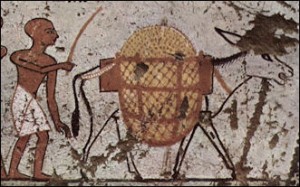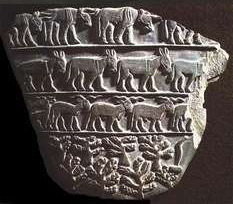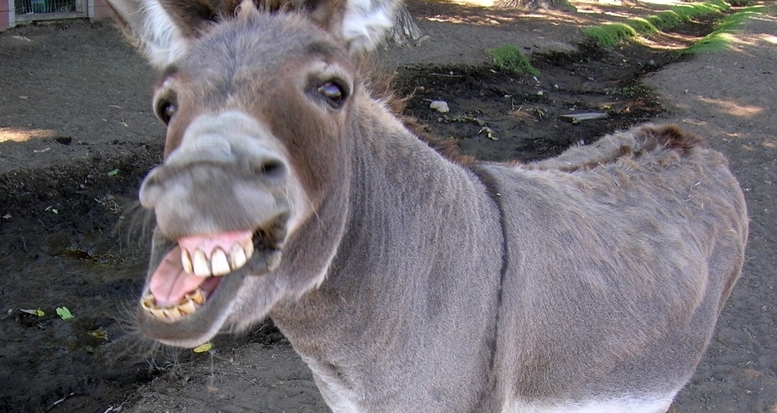Turn back the clock a good 5000-6000 years or so, to the Predynastic Naqada III period and here is your first evidence of donkey human relations. In Egypt, a decorative, carved stone called the Libyan Palette was discovered, dating back to almost 3200BC. On there was the first distinctions of hieroglyphics, indicating a written language. Also found on that stone were depictions of a four legged equid, most likely being a donkey (determined by the long ears), seeing that donkeys (especially domesticated ones) were determined to originate from North Africa and the Sahara. (The Donkey, 2013)
|
http://miltiade.pagesperso-orange.fr/GB/Ancient_North_Africa.htm |
I believe the first encounters humans had with donkeys were for obvious reasons: the hungry humans see a large, meaty animal grazing. Donkeys were hunted. Rightfully so, too, as they had a lot to offer: meat, furs, hides, and other things. Not only that, but donkeys were a relatively easier animal to hunt; donkeys do not contain the same flight response that horses do when spooked, they will fight back (Bough, 2011). Therefore, tracking down the animal wasn’t the difficult part, but maybe the killing might’ve given problems to humans. Donkeys have the ability to kick with both their front and back legs, making them a dangerous creature.
However, this was no match for humans and their highly developed brains, later tools, weapons, etc. came about to take these beasts down. Yet, somewhere in northern Africa, there were cattle farmers who realized these wild Nubian asses were consistently grazing with their cattle. Why not try and feed these meaty beasts and capture them in the process? That’s exactly what happened. (Bough, 2011)
Donkeys were kept for their meat, and they are much easier/cheaper to keep healthy and alive during the winter months (Clutton-Brock, 1992). Their adaptations to surroundings are much better than that of cattle, goats, and sheep. However, these newly devoted donkey herders realized something about these large, strong animals: they were useful for transportation.
This image is depicting a donkey, succumbing to the human’s whim by carrying whatever its owner puts on its back. Now with these newly acquired beasts of burden, humans were able to deliver goods all over their village, town, city, or even country. Humans were slowly, but surely becoming more mobile. Whether riding these animals, or strapping goods to the back, donkeys aided in the mobilization of humans. 
http://retrieverman.net/2010/07/30/the-ancestry-of-the-domestic-donkey-no-longer-a-wild-ass-guess/
As a side note to meat and transportation, donkey’s milk was also considered a delicacy. It is chemically closest to human milk of all species of animals, and was also used for medicinal purposes.
Ah, so I’ve finally made my way back to one of my main points: transportation. With this ease of access to transportation, humans could now travel farther and vaster distances, distributing goods to alien locations, making the world more globalized in the process. There are some questions, however, as to why the donkey was so easily domesticated. In other words, what did humans have to offer that was so inviting to the ass? Well:
- Shelter- a safe place to stay from predators
- Stable amounts of food during the winter months, times of drought, etc.
- Resourceful water supplies
- A chance to be with other donkeys
- less devotion on nature, less stress on gathering necessary materials to live


